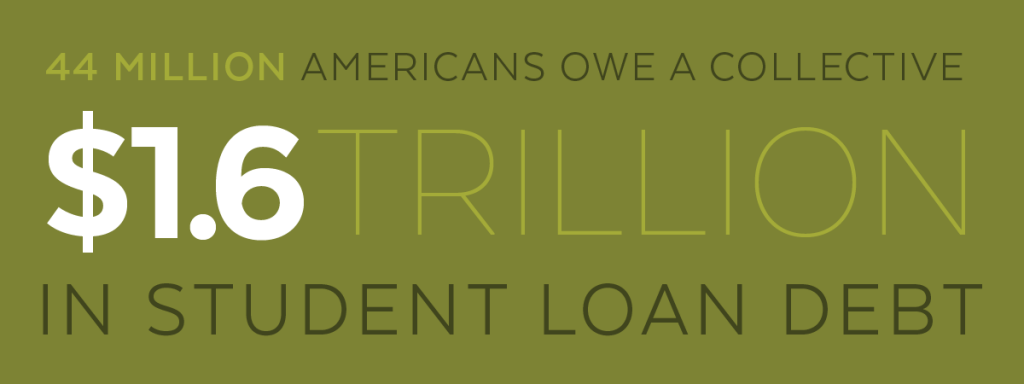How Refinancing Your Student Loans May Save You Hundreds
You just got your college degree, your professional career is on the starting line, the flag drops and you’re off. Congratulations college graduate, while you go about learning your new job you will have just six months of grace period before your loan repayments begin.
In 2020 there were around 19 million college students in America. Enrollment peaked at 21 million in 2010, or 6.5 percent of the US population, and were up from around 7 million in 1970. That’s a three-fold increase in raw student numbers and an 85 percent jump from the 3.5 percent of adults in America who went to college 50 years ago.
Meanwhile the cost of college has jumped more than 3,000 percent since 1970. Average semester tuition at public university in 1970 was $405, while at private institutions averaged $1,792. In 2019, the most recent year statistics are available, average state tuition nationwide touched just above $10,000, and private colleges topped $35,000 for a single semester.
It is currently estimated that more than 44 million Americans owe a collective $1.6 Trillion in student loan debt.
You are certainly not alone, and student loans are certainly a problem worth addressing. One of the best strategies to pay down your student loans quicker is to refinance them. Many students are actually eligible to refinance but don’t quite know where to start or do not know this is an option available to them. The first hurdle to overcome is to become familiar with how student loan refinancing works.

Understanding how refinancing works
Refinancing your loan essentially means getting a new loan with a new rate and new term that’s consolidated in order to pay off your existing student loans more quickly and efficiently. For refinancing to be worth considering, the new loan contract must lower your payments and lower the amount of interest you pay over the life of the new loan.
Refinancing vs. Consolidation – What’s the difference?
Consolidating your student loans allows you to combine your loans into one monthly payment at a fixed interest rate. You will still pay the same total amount and total interest, but now you just have one loan instead of multiple loans.
With refinancing, however, you are consolidating the loans into a single loan with a new interest rate, new term, and a new monthly payment amount. The differentiator here is that you can be saving thousands in the long run by refinancing as opposed to just consolidating.

Knowing whether refinancing makes sense for my situation
If you have many different loans, especially with different lenders, you may find it easier to make one payment instead of many. Carefully consider if refinancing federal student loans is for you, because they often come with benefits, such as loan forgiveness. Loan refinancing can make sense for you if the following situations apply to your situation:
- You do not qualify for federal loan forgiveness or cancellation. (Important note: If you refinance, you will lose the option to have your federal loans forgiven.)
- You have multiple years left on your loans. (The longer your loan term, the more you could save on interest.)
- You have one or multiple loans and your monthly payments are too high.
- Your interest rates are currently high and your credit has improved.
Qualifying for student loan refinancing
In order to refinance, you will need to qualify to become eligible—just like any other loan. Some financial institutions offer student loan refinancing for their customers or members.
As a member of Empeople, you may be eligible for student loan refinance if you have a home equity loan with us. In addition to using it for student loans, your home’s equity can be a terrific source of funds for almost any purpose. Learn more about home equity with Empeople.
Refinancing student loan with a personal loan
If you do not have a home equity loan with us, an alternative way of reducing your student loan payments is to refinance with a Empeople personal loan. You can potentially extend your payment period and your lower monthly payments.
The likelihood of refinancing improves, commonly, with time: as you work and your income improves, so does your credit score. Steady income and smart budgeting will certainly assist you in being able to refinance as you are viewed as a lower risk borrower in the eyes of the lender. Being “lower risk” should also equate to a more attractive loan term and rate.
Want to find out if you are eligible for this strategy, give us a call for a consultation.
Starting the application process
There are two options when refinancing your student loans, depending upon the type of loans you have. If you currently only have federal student loans, refinancing is usually done through the Federal Direct Consolidation Loan Program offered by the United States federal government. If you have private student loans however, you can go through the refinancing process with a credit union.
Finally, federal and private student loans can be combined into a single new loan with better rates, better terms and a simple all-in-one monthly payment as long as it is done through a credit union. Keep in mind again that refinancing federal student loans will eliminate the possible benefit that come with them.

Pay your burden down
Refinancing your loans is a smart way to ease the burden of student loan debt and could be saving you thousands of dollars in the long-run with a more affordable monthly payment. Empeople is committed to helping you along your financial journey and if you believe you meet the requirements in order to refinance, reach out to us—or better yet, stop by—and we will help you get started with the process. We might just have what you need to get ahead!



